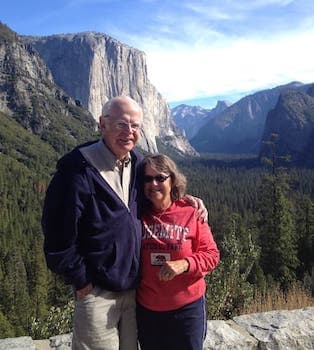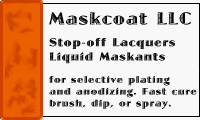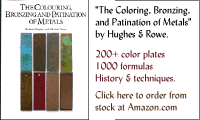
-----
How to patina copper (darken it)
Q. How do I get a patina on a selected section of a copper circle?
For instance, I have a 10-inch copper circle on which I want a half section to be lacquered and the other half being oxidized with ammonia
⇦ on
eBay or
Amazon [affil link] to get a patina.
When I tried to do this, the lacquered surface also gets a bit tarnished and goes slightly black.
I am unable to control the desired outcome.
I am using Pure Copper circles and Spray Lacquer.
- Leicester, Leicestershire
November 12, 2022
A. Hi Matthew. Apparently the spray lacquer is not an effective maskant against ammonia. Liquid maskants and "plater's tape" are two better masking agents made for the purpose ... but maybe just try black electricians' tape before exposure to ammonia. Make sure you roll it down really good at the edges (maybe with a wallpaper seam roller).
Luck & Regards,

Ted Mooney, P.E. RET
Striving to live Aloha
finishing.com - Pine Beach, New Jersey
Ted is available for instant help
or longer-term assistance.
A. Try silicone sealant.Hope it helps and good luck...
Goran Budija- Cerovski vrh Croatia
March 2, 2023
adv.
Call us at Maskcoat for all of your masking needs. 1-888-218-7227
Thanks, Jeremy
Mask Coat LLC
West Monroe, Louisiana

April 18, 2023
⇩ Related postings, oldest first ⇩
Q. Great web site. We are in Phoenix Arizona, and just installed some beautiful copper landscape lighting. Right now it is bright penny-copper new. A couple of the lamps have fingerprints from whoever packed them visible as a brown/charcoal color. I want to remove the fingerprints, then speed up a "green" patina finish, not the dull copper brown we get here in AZ. I'm from the East Coast and love the blue-green copper roof colors in Boston and Providence and would like to emulate them.
Will a weak vinegar
⇦in bulk on
eBay
or
Amazon [affil link] , 0.50 part non-iodized salt, and 1.5 parts of clear, detergent-free ammonia. Spray on the area you want to patina and reapply every 1-2 hours until you get the color you want. The patina will look powdery, leave it alone, it will eventually work in the copper and get to that more 'glazed' look. 72 hours or so from when you apply it you should have a better idea of what the final look is.
2. Brown patina.
You need to dissolve baking soda [in bulk on
eBay
or
Amazon [affil link]
in boiling water until it won't dissolve any more. Spray on to the area to be patinated after the solution has cooled, and reapply every 2 hours or so. This one will reach more towards the color of an old penny.
Blacksmith - Lenoir, North Carolina USA
